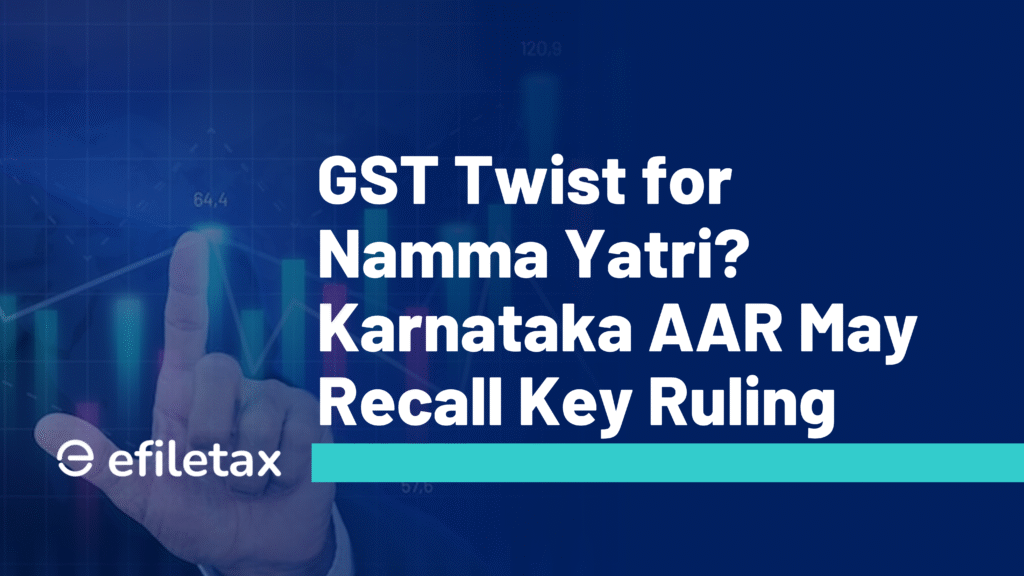
GST on Ride-Hailing Apps: Karnataka AAR May Recall Namma Yatri Ruling
Summary
The Karnataka AAR is reconsidering its earlier ruling that imposed GST on Namma Yatri, a non-profit ride-hailing app. This could have wide implications for how auto rides are taxed across India.
The focus keyphrase GST on ride-hailing has stirred fresh debate after the Karnataka Authority for Advance Ruling (AAR) hinted it may recall or revisit its earlier ruling involving Namma Yatri, a government-backed ride-hailing platform.
Let’s simplify what’s going on—and why it matters for taxpayers, commuters, and gig economy platforms.
What is the Namma Yatri Case About?
Namma Yatri is a zero-commission, open-source auto booking app supported by the Open Network for Digital Commerce (ONDC) and launched with help from the Karnataka government. It directly connects customers to auto drivers—no middleman, no fee.
But in March 2024, the Karnataka AAR ruled that even this non-profit model attracts GST, citing the platform’s role as an electronic commerce operator (ECO) under Section 9(5) of the CGST Act, 2017.
Why is GST Applicable on Ride-Hailing Services?
Under Section 9(5) of the CGST Act, the government notifies certain services where the platform itself, not the supplier (driver), is liable to pay GST. This includes:
- Passenger transport by radio-taxi
- Hotel accommodation services
- Housekeeping services
So, apps like Uber, Ola—and now Namma Yatri—are treated as deemed suppliers for GST purposes.
Why Might the Ruling Be Recalled?
The Advance Ruling Authority (AAR) now appears to be reconsidering the intent and scope of its ruling based on the following:
- No commission is charged by Namma Yatri
- It’s a non-profit, open protocol platform (open network)
- ONDC-backed, with public interest objectives
- Not a traditional aggregator (unlike Uber/Ola)
Experts argue that such platforms may not fall under the conventional definition of an “electronic commerce operator” under Section 2(45) of the CGST Act.
Key Legal Provisions Involved
| Legal Provision | Relevance in Case |
|---|---|
| Section 9(5), CGST Act | Tax liability on ECO for specified services |
| Section 2(45), CGST Act | Defines Electronic Commerce Operator |
| Notification No. 17/2017-CT (Rate) | Notifies passenger transport services under 9(5) |
| AAR Ruling (March 2024) | Applied GST to Namma Yatri under 9(5) |
Expert View: A Policy vs Law Dilemma
“This is a test of how GST law treats public-interest technology platforms differently from commercial operators. If Namma Yatri pays tax like Uber, the whole point of ONDC could be defeated.”
– Indirect Tax Advisor, Bengaluru
Impact on Other Platforms
If the ruling is recalled or revised, it could impact:
- Other ONDC-based models
- Government-supported digital platforms
- Future GST treatment of non-profit aggregators
This could also influence future policy guidelines from CBIC for digital platforms.
FAQs on GST and Ride-Hailing
Q1. Does Uber/Ola charge GST on auto rides?
Yes, GST is levied at 5% on auto rides booked via apps under Section 9(5).
Q2. What if I hail an auto directly on the street?
No GST is charged if the ride is offline (street-hail), as the driver is not a registered supplier.
Q3. Can a non-profit ride app avoid GST?
Not necessarily. If classified as an ECO under Section 9(5), it may still attract GST—unless clarified by law.
Final Thoughts
The possible recall of the Karnataka AAR ruling on GST on ride-hailing marks an important legal turning point. It reflects the growing tension between tax law and digital innovation in India.
If you’re a platform operator or service provider under ONDC, now is the time to:
✅ Reassess your GST obligations
✅ Monitor updates from AAR and CBIC
✅ Get expert guidance on compliance